
Konami Combat DigiQ remote controlled tanks
Review date: 12 April 2003.Last modified 03-Dec-2011.
First, the executive summary.
These are tiny little remote controlled tanks that fight. Up to four can play. They're a bunch of fun. They're not cheap (at least 50 US bucks per tank, plus delivery), but you get a heck of a toy for your money.
And now, the full review.
Konami's "MicroIR" DigiQ micro remote controlled cars are the oddest, and the best, of the widely spamvertised micro-toy-cars.
I reviewed a micro-car a while ago, but the DigiQ cars are quite different from it. They're controlled by remote-control-style infra-red signals, not radio, for a start. This system works surprisingly well; the cars are so tiny that they don't need very long range controllers, and they're likely to be able to see the controller anywhere in a normal room, provided you're not hiding it under a table.
The DigiQ cars' steering mechanism is also odd. Bizarre, actually, but surprisingly functional. The front wheels don't steer at all, you see. But there's one tiny motor driving each rear wheel. Independent control of those motors' speed lets the tiny cars skid-steer surprisingly effectively.
The fact that the DigiQs use skid steer makes their technology an absolute natural for a tank, of course. Tanks (and some other more commonly seen vehicles) are all skid steer, by definition. Some tracked vehicles can warp their tracks a bit for wide turns, but to change direction in a hurry, you've got to skid.
So now there are DigiQ tanks. And F1 cars, and fancied-up sports cars, and trains, for Pete's sake, but those need not detain us now.
The really interesting thing about the Combat DigiQ tanks, though, is the Combat part.
They fight and bite and fight.
Let's give them the once-over, shall we?
What you get
Combat DigiQ tanks are sold individually (well, except for the occasional special edition), and you need at least two of them to use the Combat features. This pair is a Tiger I (on the left) and a Sherman (on the right).
These are the second pair of Combat DigiQs Konami have released. The first two are a Panther and a T-34. So if you get all four, you can play a two-on-two Axis-versus-Allies game, and everybody will be able to recognise their tank.
(The four tanks released so far aren't the only Combat DigiQs out there. There's already a special edition winter camouflage T34/Panther pair with bonus obstacle set; see it here. You can buy the obstacles separately, if you like, though ordinary desk clutter works fine for spicing up the battlefield. There are also a couple of Japanese Ground Self-Defense Force tanks on the way - a Type 74, and a Type 90. They're due for release half way through 2003. The tiny Type 90 would make a nice set with the one I have already.)
You don't have to play that way, though. Any DigiQ tank can fight any other one, and any two can team up. You just have to set all of your tanks to different ID numbers. Four numbers are available, and it's easy to change.
In team mode, if you choose to use it, the tanks with IDs 1 and 3 fight the tanks with IDs 2 and 4. Simple enough.
"How small are they?", I hear you ask.
Why, they're this small.
The Tiger's 56.3mm long not counting its gun (2.21 inches), 37.7mm wide (1.48 inches) and 33mm high (1.3 inches), and weighs 27 grams, with all of its detail stuff on it except for the decorative hatch that covers the IR receiver lens and makes the tank look slightly more real, but stops it from doing anything.
The Sherman's a little smaller, and weighs 25 grams.
The controllers weigh in at about 350 grams, with batteries.
Here's the Sherman sitting on my other Sherman, a 1/16th scale Tamiya model (I've also got this one). The Tamiya Sherman could be bigger, but it's about as big a model tank as most modellers are silly enough to buy. It's also a lot closer to true scale than the DigiQ tank.
Note, for instance, the extra road wheel bogies on the Tamiya. Detail that small just wouldn't work right on the DigiQ tanks, so the Sherman loses one of its bogie sets, and the real Tiger's complex set of eight overlapping road wheel sets is abridged to three pairs of non-overlapping wheels, for its DigiQ edition.
All of the wheels turn, though. On some small motorised tank models, turning road wheels are an option.
The DigiQ tanks are very cleanly designed and moulded, and not completely cartoonish - they're not super deformed - but they're still significantly cute-ified. Scale detail fanatics will not be able to fix them, decal sets or no decal sets.
Out of the box, the tanks are almost ready to go. They lack only some cosmetic detail parts (unimportant) and their tracks (important). It takes but a moment to pop the tracks on, though.
The two tanks' tracks look very similar, but they're not the same. The Tiger's tracks are slightly longer and wider.
Like most real tanks, these tiny ones can't go anywhere if they don't have tracks. There are wheels that touch the ground - "road wheels" - but they aren't powered; the tracks are driven by sprocket wheels at the back of the hull, up above the ground.
This is why it's so very bad when a tank "throws a track", rolling the track off its drive sprocket and, usually, also off various other road and guide wheels. Loss of one or both tracks is one of the many joys of the full-sized armour world. A tank that has left its track behind, or stuffed one or both tracks under its hull, will shortly be offering some people of lower rank an afternoon's healthy exercise.
The DigiQ tanks are so tiny, and their tracks are so loose (to reduce drag, and to protect the drive sprockets from damage if something jams the track), that ordinary short-pile carpet is a somewhat challenging surface for them. Turn hard on carpet and you'll throw a track, sooner or later.
(Rubber tracks are lousy for off-road use at the best of times; loose rubber tracks are even worse. I've reviewed a couple of rubber-track toy tanks, one a bit bigger than the DigiQ models and the other quite a lot bigger. Neither of them can conquer any lawn that's hairier than a putting green. )
You can pop the tracks back on very easily - a corporal with a 15 pound sledgehammer is unlikely to be needed - but that's no good in the middle of a fight. So you have to restrict your play to smooth surfaces.
That's OK, though. The Combat DigiQs are so small that you can stage a satisfying battle on a coffee table. You don't have to use the carpeted floor. And they are tracked vehicles, so they can clamber over small obstacles quite successfully.
Anyway, once the tracks are on, you only have to do three more things before you start playing.
One: pop some batteries in the controllers. As with other micro-toys, these transmitters run from ordinary AA cells. In this case, you install them in one of the hand-grip sides of the transmitter. There's the usual little embossed diagram to show you which batteries go which way up, but you may have to look hard to see it.
Two: Charge your tanks.
Another feature the DigiQ tanks share with other micro-toys is their tiny internal rechargeable batteries. You charge the tanks by clipping them onto the transmitter. They charge in about 10 minutes, and run for up to 15 minutes, which is good. Short run times are OK for little cars which people only want to race for a few minutes at a time; most tiny-toys charge faster than the Combat DigiQs, but don't run for very long. For prolonged strategic armour engagements, you want some more duration.
If you're bashing over desk clutter or playing sumo games, you can expect rather less than 15 minutes of run time from a Combat DigiQ charge. If you're playing a wily lurking urban combat scenario in a town constructed from something appropriate, you may get quite a bit more than 15 minutes.
The tanks seem to hold their charge OK, too; if you charged them yesterday and played one five minute game, there's a good chance that you'll be able to play another five minute game today without more charging.
The controller I got with my DigiQ Tiger appears to have a minor contact defect. Sometimes, when there's a tank clipped to the back of it, you can't quite turn the controller off completely. Its LED display stays on, dimly, when the power switch is in the off position. This doesn't happen every time the tank's attached, though, and I don't think it causes much mischief when it does happen.
The charging dock is on the back of the controller, and the tanks clip into it quite easily. There's a release button for when you want to get them out again.
Many tiny-toys have very cheesy charging arrangements, with flimsy clips and lousy contacts. The DigiQ tanks charge much more easily.
On the undersides of the tanks, there's a tiny power switch (chronic fingernail-biters will need to use a pointy object to flick it), the contacts and clip-holes for the charging dock, and an exceedingly small but very bright surface mount reddish-amber LED at the front.
The LED illuminates the surface under the tank and directly in front of it, and it's all the tank has to indicate its status, besides motor activity. There's no room for a speaker in these things.
You get a flash from the LED when you turn a tank on, and another flash when it's been informed of the presence of a controller, or had its ID number changed. The LED flashes frantically when a tank gets shot, and a shot tank will also spin back and forth in place in a very undignified way.
When you've only got one or two hits left before you die, the LED flashes regularly. When a tank's been killed, the LED flashes faster for a while.
Step three in the preparation-for-your-first-drive process is to set the tanks' ID numbers; they have to be different. You set the number by setting the controller's mode switch to the bottom position, turning on the tank and the controller, placing the controller so that it straddles the tank, and pressing the ID change button.
ID rewriting is a bit touchy; the tanks have a low tolerance for interference in this mode, presumably to stop IR noise from rewriting their ID in mid-battle. If you can't rewrite the ID, move the tank somewhere where there's less IR noise; I couldn't do it on the desk in my fluorescent-lit office (fluoros are known for their near-IR interference output). Just controlling the tanks in the office was a bit flaky with the fluoro on.
The IR control system also makes these tanks allergic to sunlight. Direct sunlight has a whole bunch of near-IR in it, which floods the sensors and renders them useless. Ordinary IR remote controls have the same problem.
The Combat DigiQ control system gives you four IR "channels" to choose from, and two tanks of the same model on the same channel will presumably respond to the same transmitter at once, possibly allowing you to create a Tiny M4 Sherman Precision Driving Team. Two different-model tanks won't respond to one controller, though...
...because each controller has an interchangeable plug-in "tank-sensing recognition ROM" module. If you've got the wrong module plugged in for the tank you're trying to control, nothing will happen.
Deciphering things
The Combat Digi-Q documentation is excellent - if you can read Japanese.
If you can't, then it's pretty opaque, despite the diagrams.
If Japanese characters ain't your thing, the control panel will probably puzzle you.
Fortunately, Konami provide an English manual in PDF format here. It's just a bunch of crunchily compressed bitmap images of pages, but that'll do.
Konami's other Combat DigiQ pages are all in Japanese, as I write this. English-speakers can Babelfish the other pages to make them a tad more comprehensible.
Babelfish is worth it purely for lines like " Also the battle incandesced and it was large prosperity", if you ask me.
There are also a few English Web pages on reseller sites that show you how to get your Digi-Q tanks going, like for instance HobbyLink Japan's page here, and ToyEast's one here. I think these pages must have gone up before the English manual was available, because it's really quite easy to understand.
Playing with them
To initialise your Combat DigiQ, you turn the tank on, then turn on the controller in whichever of the three play modes you want to use. The controller sends an initialisation message to the tank that tells it how to behave. People with learning IR remote controls could well cause considerable mayhem in a Combat DigiQ fight.
Unlike various cheap R/C toys, the DigiQ tanks don't do anything if they don't receive a message. IR noise is very likely to just confuse them into doing nothing, not induce them to move.
Many radio control enthusiasts have had it drummed into them that you always turn on the transmitter before the model. It's not such a big deal now, because decent modern R/C toys generally have quality fail-safe mechanisms that cause them to do a whole bunch of nothing when they don't get a clear signal. But they still might get some signal or other from some other oddball transmitter in the neighbourhood, if the real transmitter isn't there to drown it out. And you might be using an old-style model, or one that's got a super-cheap receiver, in which case random radio hash can and will cause the model to have an epileptic fit if it's on but its transmitter isn't.
So you turn the TX on before the RX, full stop.
The DigiQ tanks aren't like that, though. And even if they were, the worst they could do if they went nuts is bumble angrily around in small circles. They don't have a razor sharp foot-wide propeller, or 2.5 motor horsepower split among four tractor-tread wheels.
Considering their size and price, the Combat DigiQs are very fun toys.
Controlling them isn't hard. Left thumb for throttle, right thumb for steering. Steering all the way sideways, throttle slightly forwards, gives you a pirouette, with the tracks turning in opposite directions to turn the tank on the spot. Full throttle gives you drive from one track, and brake on the other; this is how most real tanks turn, as pirouetting requires a fancier drive system.
Use of pirouettes to apply wax to your mouse pad is perverse, and therefore recommended.
Oddly, if you steer with the tank stationary and then move the stick all the way backwards, you'll get a reverse pirouette; if you move the sticks to that same position without stopping for a moment first, you'll get a reverse brake-steer.
The Tiger I got is noticeably faster than the Sherman. This is probably just because its track drive sprockets are bigger. If the gearing inside's exactly the same, bigger drive wheels mean more speed.
Anyway, the Sherman manages around 0.55 kilometres per hour (0.34 miles per hour); the Tiger does more than 0.7km/h (0.45mph). This doesn't give the Tiger a huge combat advantage, but it'd be important in a race.
The Sherman's lower speed gives it more torque; it could push the Tiger around easily, were it not for these tanks' tendency to just climb all over each other when they come into contact. If you're looking for a pullin' tank, the Sherman's clearly the better of this pair.
There DigiQs have three play modes - practice, regular battle and expert battle - but they don't affect the tanks' speed, except when you've taken a few hits in the battle modes. Then, you slow down.
In practice mode, you've got infinite ammo, infinite armour and no reload time; you can shoot non-stop if you like. This is the mode to use for races; shooting another tank just slows it down, a la certain console games.
In the regular battle mode, you've got infinite ammo and a fixed three second reload time, but can only take five hits, no matter what tank you have and no matter who shot you.
In the expert battle mode, though, tanks get different armour and ammo and shot damage and reload time depending on what kind of tank they are.
Of my two tanks, the Sherman gets 35 shots and a speedy two second reload time in expert mode, but does tiddly damage and has little armour.
The Tiger gets a miserable 12 shots, with a five second reload time. But if it hits you, you stay hit.
The Tiger can kill the Sherman with only two hits; the Sherman has to shoot the Tiger eight times to kill it.
Whenever you've fired a shot in either of the battle modes, the red Busy light on the controller glows to indicate the reload delay. The green OK light goes on when you're ready to shoot again.
In all of the modes, there's a grace period of a few seconds after you've been shot, during which you can't be hit again. This compensates for the I've-been-hit spin, which can leave you pointed in an unhelpful direction.
The tanks' turrets aren't stuck pointing forwards; they can traverse through more than 90 degrees, for crafty angle shots. But they're not motorised; you have to move them by hand.
At any point during a fight, you can re-initialise your tank to zero damage and full ammunition by just turning your controller on and off. The switches aren't silent, the tank flashes when it's re-initialised, and the re-init process takes four seconds. So good luck getting away with that one without your opponents noticing. It's a good way of getting back in the game quickly after being knocked out, though; otherwise, you have to sit around dead for a little while before the tank re-inits by itself.
For fairer handicapping, you can mix battle modes. New players can cruise around in invulnerable practice mode while everyone else actually fights. Experienced players can use expert battle mode while other people use regular battle mode.
There's a steering trim knob on the controller panel, to let you tell your tank how to drive straight, but it's impossible to get the trim perfect. Tweak the trim so that the tank goes straight at low speed, and it'll probably curve a bit at high speed. You're probably not drag racing these things, though, so it's not a big deal.
The Combat DigiQs have proportional control - degrees of movement in all directions, not just forward or back, left or right. There seem to be six speed steps in forward, four in reverse, and five turn steps each way, but you'll need very steady joystick thumbs to perceive the steps clearly.
The tanks' maximum turn speed is a bit fast for newbies, but a gentle hand on the control sticks will let you point them pretty much where you want them to go, and their maximum turn speed is not too fast to stop someone with a bit of experience from aiming accurately.
There's a bit of delay in the control system; the tanks don't always respond instantly to commands, like an R/C model. They're close enough as makes no difference for most purposes, though; really noticeable delays indicate IR noise or a bad line of sight between the controller and the tank.
About the only thing that these tanks don't do is shooting while moving. You have to stop before you can fire. But, once stopped, you can fire instantly.
The only way to tell that a tank just took a shot at you, if you didn't notice the person controlling it pressing the trigger button, is that it'll "kick" back about an inch.
It is quite possible for people engaged in tabletop battles to fall off the edge as a result of this simulated "recoil" (shoot like crazy in practice mode and you'll reverse continuously), or just because of bad steering. Opinions are divided on whether falling off should constitute a forfeit.
The tanks are light and tough enough that they can take a few falls onto a hard floor without damage. Better they should fall on carpet, though; if you've got a hard floor, you might as well run the tanks there.
Konami's quoted transmitter range for the Combat DigiQs is about two metres, with an angle of coverage in front of the transmitter of about 60 degrees, but that's very conservative. I found it easy to maintain reasonable control at five metres; at closer ranges, IR bouncing off surfaces meant the controller could be pointed nowhere near the tank and still work.
It's also possible for a Combat DigiQ to score a hit on another tank more than five metres away, too, but it's very difficult indeed. The maximum range the "guns" are supposed to have is only one metre, with about a ten degree field of view. Reflective and refractive surfaces can change this, though; extreme show-offs can use cutlery and glassware to devastating effect.
The Combat DigiQ controllers are worthy of special mention. Cheap micro-toys have nasty plasticky controllers; Combat DigiQs don't.
The controllers are a comfortable size for adult hands...
...and the concave-mushroom thumb-sticks are pleasing, too. They feel like a good game console controller stick; quite solid and satisfying.
Dressing them up
The tanks are ready to go as soon as you pop on the tracks, but they lack some little detail parts that you can stick on if you're so inclined...
...and sufficiently coordinated.
This minuscule object is an exhaust stack centre for the Tiger; it has two. The weeny front machine guns for each tank probably have even less plastic in them, but are easier to insert (with needle-nosed pliers or tweezers) into the matching hole in the front of the hull. The exhaust stacks are... fiddly.
This shovel on the front of the Tiger is about 14 millimetres (9/16ths of an inch) long.
To attach the scale parts, I just used supermarket superglue. I've given up buying expensive hobby shop cyanoacrylate unless I really need water-thin glue for something, because I seldom get to use more than half of a bottle of the stuff before it turns into a lump of solid plastic. The cheap stuff worked fine, as usual.
The scale parts come on sprues, just like the parts for larger models. You snip 'em off with side cutters, (optionally) clean 'em up with a hobby knife and appropriate paint, then stick (almost all of) 'em in place.
The only scale parts that aren't meant to be glued down are the hatch covers that go over the receiver lenses:
You have to take them off if you want to play with the tanks.
Personally, I don't mind the look of the bare lenses. If you're not very careful, you're likely to lose the hatch-caps anyway; they just sit on the lenses and don't lock in place in any way.
The lens, incidentally, isn't rotationally symmetrical; it's biased to make the tanks realistically more vulnerable from some directions than from others. For a long range hit, you want an aim line more or less perpendicular to one of the turret's faces, not coming in diagonally.
Giblets
The tanks' "guns" don't actually fire through the gun barrels; they're infra-red LEDs that peer out through holes next to the guns.
Remove a few screws and the tanks come apart easily.
The printing on the tiny two-cell battery pack says "2MR80AAA SH4PNIMH", which means they're nickel metal hydride cells (normal, for micro-toys), and probably means they have a capacity of 80 milliamp-hours (mAh).
Eagle-eyed readers will have noted that there's a ring of gear teeth inside the turret, and just barely room enough inside the hull of the tank (behind the batteries) for another tiny motor and some manner of gear train, presumably with a shaft going up to a pinion to rotate the turret.
Yes - this means there are powered-turret Combat DigiQs on the way.
Check out the video clip (replete with stirring music and sound effects calculated to give the impression that these tiny tanks are actually at least 20% larger than the originals) here (or here, in pseudo-English) to see the upcoming models in action.
That clip also, by the way, shows the frantic flashing rotating I've-been-hit behaviour of the tanks, and gives you a brief glimpse of the IR control LEDs blinking away on the controller (the CCD-sensor video camera that shot the clip can see near IR; the human eye can't). It also demonstrates how the standard controller operates the extra-function tanks. It would appear that if the tank isn't moving and you move the steering stick, you traverse the turret. That seems logical.
Konami haven't said when the motorised-turret DigiQs are going to be on sale, though. They could take a while.
Power
In operation, the transmitter draws about 15 milliamps (mA) most of the time, with 50-odd milliamp bursts every few seconds. The average draw should be below 20mA, which is a nice light load for alkaline AA cells. Even budget alkalines should last for a hundred-odd hours into that load.
The charge current's a lot more ferocious, though; charging draws more than 200mA, ramping down as the tank's battery fills. When I tried sticking a half-charged tank back in the dock, it drew 230mA through my multimeter.
This is a more serious load for alkalines, though still not high enough to badly affect their useful capacity (the higher the load, the less capacity you'll get out of the cells).
If you do nothing but charge, you can expect five to ten hours of service depending on the quality of your alkalines. Brand name cells ought to manage at least eight hours of charging service.
Eight hours of Combat DigiQ charging is, of course, about 48 consecutive charges. So in real world use, assuming a full charge worth of postprandial tank battles every day, it's reasonable to expect four ordinary alkalines to last more than a month.
With this little battery depletion, I don't think there's a lot of reason to bother with rechargeable AAs for these things, and only real enthusiasts need shell out for the optional four-tank charger, with or without the matching AC adapter.
It seems likely to me that the DigiQ charge system's connecting the AA cells to the tank batteries through nothing much more sophisticated than a resistor, so there's no voltage/amperage conversion going on. The current flowing through the AAs is therefore likely to be the same as the current flowing through the tiny NiMH cells; 230mA for these cells approaches a "3C" charge. That's just outrageous, by NiMH standards.
The "C" in "3C" relates to the cell capacity; the number relates the charge current in amps to the cell capacity in amp-hours. Charging a battery with a capacity of X milliamp-hours at X milliamps - so the charge will be over in one hour, plus a bit to allow for the imperfect efficiency of the process - is called a "1C" charge.
For all but the most special fast-charge NiMH cells, a 1C charge is as hard as you can go. Even then, you need a clever charger that monitors cell temperature as well as voltage, if you want to avoid an early death for your batteries.
Micro remote control toys get away with a 2C to 3C charge by simply not finishing it. They don't fill up the batteries. It's when the batteries are full, but the charge current keeps coming, that damage is really done; hard charging is still not great, but it's a lot less harmful if you stop early.
200-odd milliamps for ten minutes is 2000 milliamp-minutes, which is 33 milliamp-hours. If the Combat DigiQ battery's capacity is 80mA, a "full" charge won't even half fill the cells. This also means that the cells should be able to deteriorate quite a lot before you'll notice any loss of run time. So even if the charge current is thrashing the skin off them, the tank should still work well for a long time.
Other options
If you want tiny tracked vehicles that do battle, Combat DigiQs are the only way to go, as of April 2003.
If you can live without the tracks, though, the Smartland Micro Combat Vehicle (which doesn't appear to have a home page; this retailer page is good) combines a regular R/C micro-car chassis with an IR gun and up to three-way combat, at a less alarming price.
If you want a tiny tank that doesn't fight, Dragon's 1/72 scale "Palm-top R/C Armor" tanks are only about 4.5 inches long and have excellent scale detail. There are lengthy but low quality movie clips of these tiddlers here.
Takara also make R/C tanks without functioning guns; check them out here.
Overall
Any hard surface is a suitable playground for Combat DigiQs. Coffee table? Perfect. Desk? Fine. Dinner table? Sure. They're OK on an ordinary hard floor, as well, but tables replete with obstacles make things more fun; when your dinner party reaches the coffee-and-biscuits stage, the table will be adequately cluttered for a few rousing rounds of DigiQ combat.
Those on the nerdcore cutting edge will whip a portable TV and an Atari 2600 out from under the table, of course. But the rest of us are likely to dig the non-virtual tanks.
Do I like these things?
Yes I do. I think I need another two.
Takara/Konami aren't going to give up on DigiQ development with these, of course. The motorised-turret versions will presumably be hitting the market some time reasonably soon, and who knows what else is in the pipeline. If you want fancier features, just wait.
But even in their current trim, these things rock.
You know you want some.
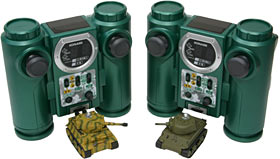

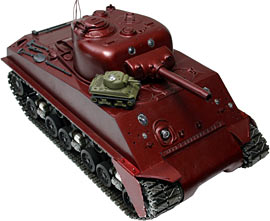
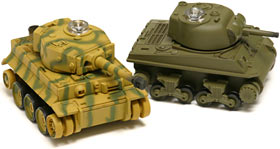

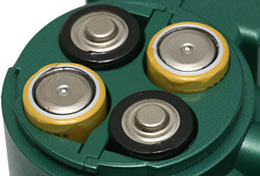
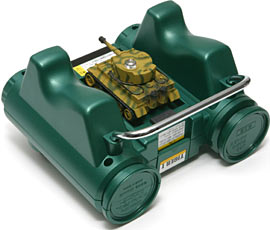
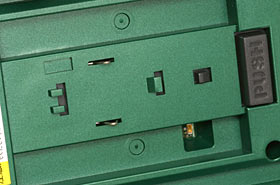


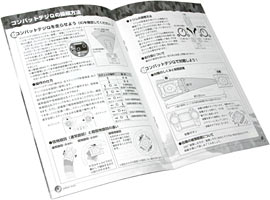




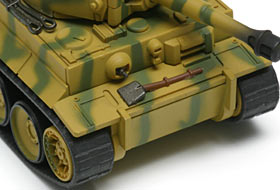
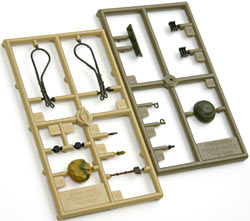
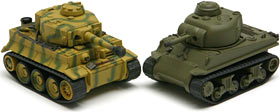
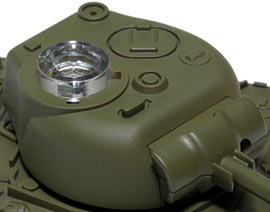
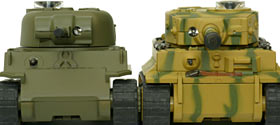
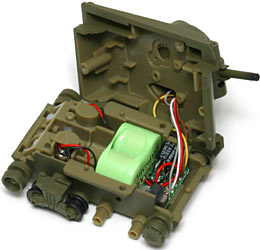


![[SecureWebs]](images/sw.gif)